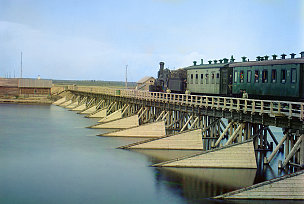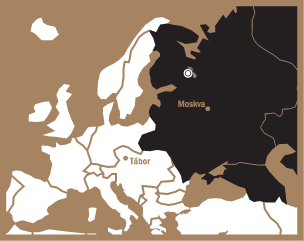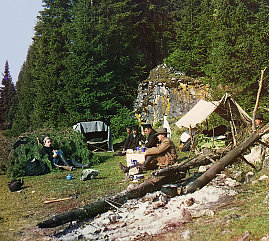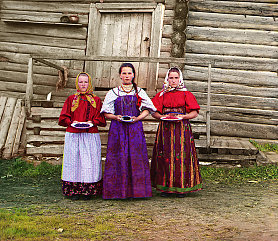S. M. Prokudin-Gorsky: The Splendors of Russia in Natural Color 1905–1916
Exhibition of Šechtl & Voseček Museum of Photography February–May 2006


Этюд у водопада Кивач.
At Kivach waterfall.
Library of Congress, Prints
and Photographs Division,
Prokudin-GorskiiCollection,
LC-DIG-ppmsc-04652. Digital color rendering by Walter Frankhauser.
https://hdl.loc.gov/loc.pnp/ppmsc.04652


Вид Соловецкого монастыря с суши.
View of the Solovetskii Monastery from land.
Library of Congress, Prints
and Photographs Division,
Prokudin-GorskiiCollection,
LC-DIG-ppmsc-03961. Digital color rendering by Walter Frankhauser.
https://hdl.loc.gov/loc.pnp/ppmsc.03961


Военнопленные австрийцы у барака.
Austrian prisoners of war near a barrack. Karelia.
Library of Congress, Prints
and Photographs Division,
Prokudin-GorskiiCollection,
LC-DIG-ppmsc-04423. Digital color rendering by Walter Frankhauser.
https://hdl.loc.gov/loc.pnp/ppmsc.04423


Группа.
Group. (Myself with two others, Murman)
Library of Congress, Prints
and Photographs Division,
Prokudin-GorskiiCollection,
LC-DIG-ppmsc-03940. Digital color rendering by Walter Frankhauser.
https://hdl.loc.gov/loc.pnp/ppmsc.03940


На дрезине у Петрозаводска по Мурманской ж. д.
On a handcar near Petrozavodsk, on the Murmansk Railroad.
Library of Congress, Prints
and Photographs Division,
Prokudin-GorskiiCollection,
LC-DIG-ppmsc-03951. Digital color rendering by Walter Frankhauser.
https://hdl.loc.gov/loc.pnp/ppmsc.03951


Ж. д. мост через реку Шую.
Railroad bridge over the Shuia River.
Library of Congress, Prints
and Photographs Division,
Prokudin-GorskiiCollection,
LC-DIG-prokc-20246. Digital color rendering by Jan Hubička based on color composite by Blaise Agüera y Arcas.
https://hdl.loc.gov/loc.pnp/prokc.20246


Неизвестно. В альбомах нет отпечатка.
Unidentified. No print in the albums.
Library of Congress, Prints
and Photographs Division,
Prokudin-GorskiiCollection,
LC-DIG-ppmsc-04413. Digital color rendering by Walter Frankhauser.
https://hdl.loc.gov/loc.pnp/ppmsc.04413


Ночевка у камня на берегу Чусовой.
Overnight camp at the rock on the bank of the Chusovaya River.
Library of Congress, Prints
and Photographs Division,
Prokudin-GorskiiCollection,
LC-DIG-ppmsc-04445. Digital color rendering by Walter Frankhauser.
https://hdl.loc.gov/loc.pnp/ppmsc.04445


Часовня на месте, где был в древнее время основан г. Белозерск.
Chapel on the site where the town of Belozersk was founded in ancient times.
Library of Congress, Prints
and Photographs Division,
Prokudin-GorskiiCollection,
LC-DIG-ppmsc-04420. Digital color rendering by Walter Frankhauser.
https://hdl.loc.gov/loc.pnp/ppmsc.04420


Место заточения князей Воротынских.
Site of the imprisonment of the Vorotynskii princes.
Library of Congress, Prints
and Photographs Division,
Prokudin-GorskiiCollection,
LC-DIG-prokc-21033. Digital color rendering by Jan Hubička based on color composite by Blaise Agüera y Arcas.
https://hdl.loc.gov/loc.pnp/prokc.21033


Крестьянские девушки.
Peasant girls.
Library of Congress, Prints
and Photographs Division,
Prokudin-GorskiiCollection,
LC-DIG-ppmsc-03954. Digital color rendering by Walter Frankhauser.
https://hdl.loc.gov/loc.pnp/ppmsc.03954

На сенокосе около привала.
In a hayfield near the landing.
Library of Congress, Prints
and Photographs Division,
Prokudin-GorskiiCollection,
LC-DIG-ppmsc-04422. Digital color rendering by Walter Frankhauser.
https://hdl.loc.gov/loc.pnp/ppmsc.04422


Группа детей.
Group of children.
Library of Congress, Prints
and Photographs Division,
Prokudin-GorskiiCollection,
LC-DIG-ppmsc-04421. Digital color rendering by Walter Frankhauser.
https://hdl.loc.gov/loc.pnp/ppmsc.04421


Село Колчеданское.
The village of Kolchedanskoye.
Library of Congress, Prints
and Photographs Division,
Prokudin-GorskiiCollection,
LC-DIG-ppmsc-04446. Digital color rendering by Walter Frankhauser.
https://hdl.loc.gov/loc.pnp/ppmsc.04446


Работа на Бакальском руднике.
Work at the Bakalsk ore mine.
Library of Congress, Prints
and Photographs Division,
Prokudin-GorskiiCollection,
LC-DIG-ppmsc-04428. Digital color rendering by Walter Frankhauser.
https://hdl.loc.gov/loc.pnp/ppmsc.04428


Формовка художественного литья.
Molding of art castings.
Library of Congress, Prints
and Photographs Division,
Prokudin-GorskiiCollection,
LC-DIG-ppmsc-04425. Digital color rendering by Walter Frankhauser.
https://hdl.loc.gov/loc.pnp/ppmsc.04425


Деталь храма.
Detail of the Church.
Library of Congress, Prints
and Photographs Division,
Prokudin-GorskiiCollection,
LC-DIG-ppmsc-03947. Digital color rendering by Walter Frankhauser.
https://hdl.loc.gov/loc.pnp/ppmsc.03947

Хижина поселенца Артемия по прозвищу Кота, живущего на этом месте более 40 лет.
Hut of a settler Artemii nicknamed Kot (cat) who has been living on this place for more than 40 years.
Library of Congress, Prints
and Photographs Division,
Prokudin-GorskiiCollection,
LC-DIG-prokc-20791. Digital color rendering by Jan Hubička based on color composite by Blaise Agüera y Arcas.
https://hdl.loc.gov/loc.pnp/prokc.20791


Пинхус Карлинский, 84 года, 66 лет на службе. Надсмотрщик Черниговского водоспуска.
Pinkhus Karlinsky, 84 Years old, 66 years in service. Supervisor of the Chernigov flood gates.
Library of Congress, Prints
and Photographs Division,
Prokudin-GorskiiCollection,
LC-DIG-ppmsc-03966. Digital color rendering by Walter Frankhauser.
https://hdl.loc.gov/loc.pnp/ppmsc.03966


Пожарная команда в г. Вытегре.
Fire Brigade exercise in the town of Vytegra.
Library of Congress, Prints
and Photographs Division,
Prokudin-GorskiiCollection,
LC-DIG-prokc-20954. Digital color rendering by Jan Hubička based on color composite by Blaise Agüera y Arcas.
https://hdl.loc.gov/loc.pnp/prokc.20954


Гонки на канале Петра I, г. Шлиссельбург.
Lumber rafts on the Peter I Canal, town of Schlusselburg.
Library of Congress, Prints
and Photographs Division,
Prokudin-GorskiiCollection,
LC-DIG-ppmsc-04417. Digital color rendering by Walter Frankhauser.
https://hdl.loc.gov/loc.pnp/ppmsc.04417


Кольчуга и шлем Преподобного Далмата.
Saint Dalmat's hauberk and helmet.
Library of Congress, Prints
and Photographs Division,
Prokudin-GorskiiCollection,
LC-DIG-ppmsc-04659. Digital color rendering by Walter Frankhauser.
https://hdl.loc.gov/loc.pnp/ppmsc.04659


Город Далматово. Вид на западную часть с колокольни монастыря.
City of Dalmatov. View of the western section from the monastery's bell tower.
Library of Congress, Prints
and Photographs Division,
Prokudin-GorskiiCollection,
LC-DIG-ppmsc-04656. Digital color rendering by Walter Frankhauser.
https://hdl.loc.gov/loc.pnp/ppmsc.04656